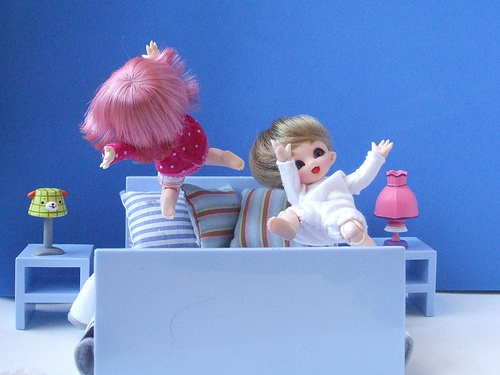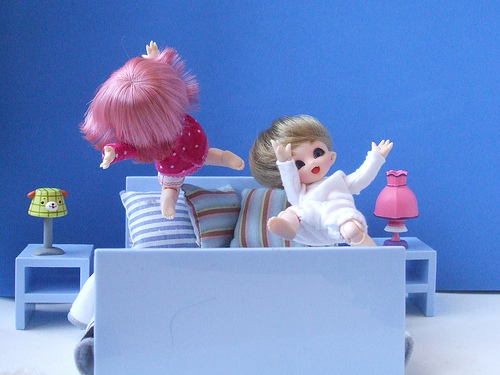 Whee! Living small is fun!Photo: Anna MSo you want to raise your family in a city but can’t afford much square footage? Never fear. Despite the challenges, it’s possible to live in a small space — with kids — without sacrificing your sanity.
Whee! Living small is fun!Photo: Anna MSo you want to raise your family in a city but can’t afford much square footage? Never fear. Despite the challenges, it’s possible to live in a small space — with kids — without sacrificing your sanity.
First, let’s define small, since our idea of an acceptable amount of space has changed dramatically in the past several decades. In 1950, the average American home was 983 square feet, and the average household size was 3.54 people. Today’s “average” home is close to 2,500 square feet, even while average household size has decreased to 2.67 people.
For the purposes of this piece, I’ll define small as between 500 and 1,000 square feet. Obviously, the challenges of raising kids in a space of this size will vary greatly depending on the amount of storage (whether or not there’s a garage, basement, or on-site storage unit), access to outdoor space like a patio or backyard, how the home is configured, and how many people live in it. And, of course, each city and neighborhood has its own strengths and challenges (our neighborhood, for example, has a great library and plenty of parks and community resources, but not much retail) so not all of the suggestions will apply to all cities.
That said, here are some general tips to help make small-space city living easier for parents — and everyone.
Make “stuff” earn its keep
Before you go gangbusters on the baby gear (or kitchen gadgets, or tools), make sure it will be worth the space it will take up. Ask yourself if you really need a swing and a bouncy chair, or a wipe warmer (yes, there is such a thing), or a gazillion toys for every stage of your child’s life. A good rule of thumb with stuff is to wait until you have a demonstrated need for an item before you acquire it. We started pretty lean on the baby gear (though we did end up with a few hand-me-down chairs we definitely could have done without) and then eventually decided (right before the birth of our second) that it was worth it to us to have two strollers. We don’t own a car and needed a compact, lightweight stroller for the bus, but we found that compact and lightweight wasn’t especially comfortable for our regular long walks — to do errands and to visit friends.
Think vertical
If you don’t have much closet or storage space, take advantage of unused wall space. Our two kids had way too many stuffed animals, most of which were given as gifts at their births or “just because.” My kids never played with the stuffed animals, but I felt guilty giving them away, since they were gifts from people who are important in their lives. So, instead of shoving the animals into their already packed closet, we installed some high display shelves and stored them up there. Voilà! The stuffed animals remained, the kids’ room looked more festive and “kid-like,” and their closet and floor space were spared. Win-win-win.
You can also use vertical space to store books, display knick-knacks, or even to store not-yet-grown-into clothes. In the kitchen, you can hang pots and pans — provided, of course, that your pots and pans aren’t as tacky and worn-out as mine.
Choose multipurpose, foldable furniture
Coffee tables, seating, and even beds with storage are a city parent’s friend. So are futons and fold-out sofas. For items you don’t use every day, see if you can find a version that is easy to stow away. We have a folding play table that we use for coloring/Play-Doh/tea parties and then store under our daughter’s bed, and folding chairs that we pull out when we have more than a few guests. We even have a folding bike, which (before our recent move) we stored in our entry closet.
Downsize appliances
If you have a standard-size water heater that’s on its last legs, consider replacing it with a tankless version. This will free an entire closet for storage and have the added benefit of saving energy and money. A smaller and/or stackable washer and dryer can free more floor space.
Digitize it
I am the original sentimental pack rat. I used to save everything: programs from plays, ticket stubs from concerts, birthday and holiday cards, napkins from friends’ weddings, and every scribble my kids ever did. I’m so bad, I used to dry and save flowers from bouquets my husband gave me. One year (perhaps not coincidentally, shortly before our first child was born), he suggested I take a picture of the bouquet instead of saving the actual flowers. Brilliant! Since then, I’ve been more content to take photos of items I’d like to preserve and to allow photos of an experience to serve as my souvenir. Sure, there are certain things I still save (Prince concert ticket stubs, a particularly special piece of kiddie artwork), but I’m becoming more willing to use pictures and (electronic) written memories as keepsakes.
You can also store other types of clutter electronically. Scan important documents instead of filling file cabinets. Rip CDs (or, if you want to keep the physical media, store them in CD books and get rid of the covers). Yes, you’ll need a backup solution, but an extra hard drive takes up a lot less space than all the stuff you’ve been hanging onto.
Stash stuff with your neighbors
If you know people in your neighborhood with kids, consider forming a “swap co-op.” If you’re finished with your baby swing but anticipate needing it in the future, you can pass it on to a co-op member with a tiny one, who will then pass it on to you when (if) you need it again. Ditto with hand-me-downs, toys, car seats, et cetera. A system like this (whether formal or informal) will save money and resources as well as space in your home.
The world is your backyard — go play in it!
Some people fear that living in a small space with children will make them claustrophobic and their children bored. But urban life means rethinking the relationship between home and community. Instead of thinking of your home as the place that meets all of your entertainment and recreation needs (media room, huge yard, play area, et cetera), think of it as a springboard that provides easy access to all of the enriching opportunities a city can provide. Use the library regularly instead of storing tons of books in your home. (We also use our library for story time, puzzles, and, in the summer, a cool place to hang out on 90+ days.) Visit nearby parks for outdoor time — and to meet other families in your neighborhood. Other options: museums, community centers, public pools, window shopping, neighborhood walks, coffee shops, bus and train rides, street fairs, farmers’ markets — you get the picture. The opportunities for entertainment in a city are almost endless. Yes, this means leaving your house frequently, even in poor weather.
But let’s face it: No matter where you live, you can’t stay there every waking minute. No matter how much stuff there is to do at home — and my suburban friends with large houses and yards and rooms full of toys will back me up on this — kids almost always prefer to go somewhere else.
Do you live with kids in a small space? Share your own tips in the comments.



